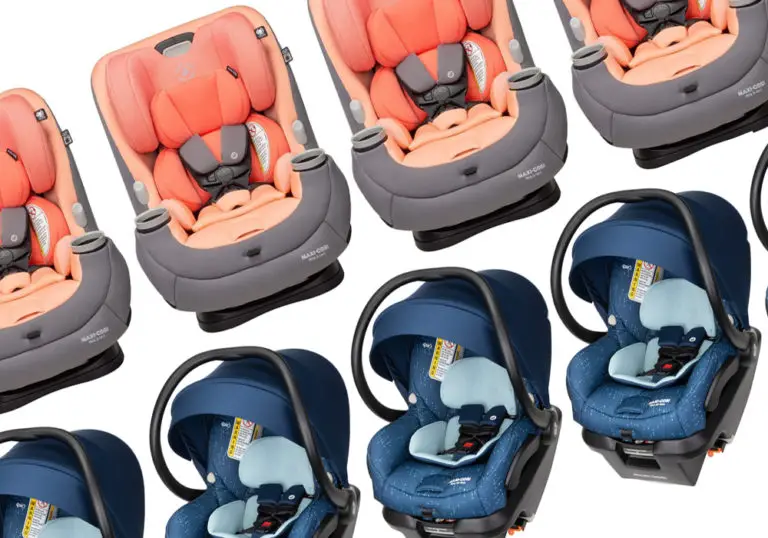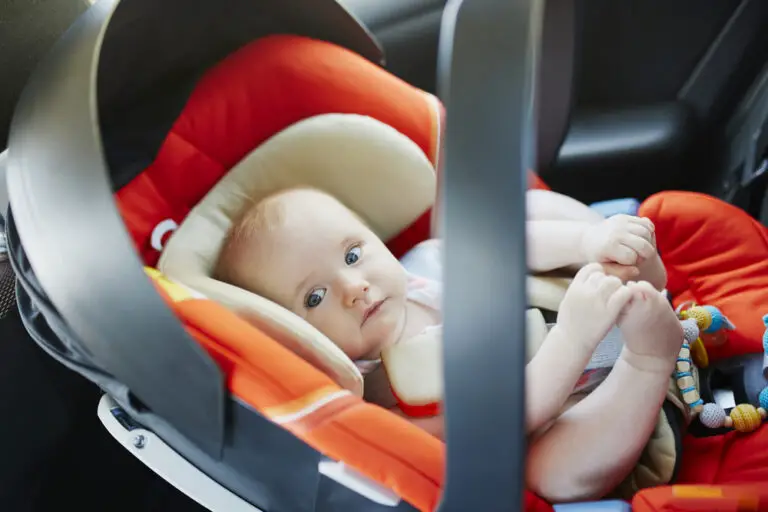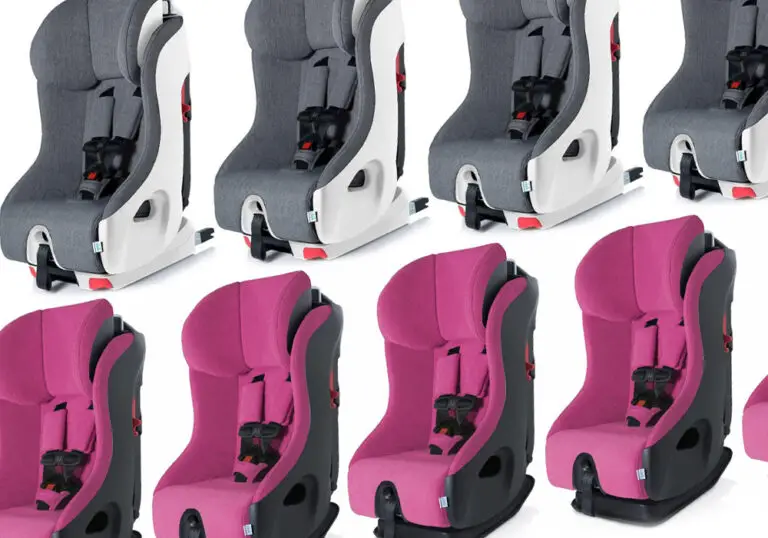Maryland Car Seat Laws 2024 (Rear, Forward & Booster)

Maryland car seat laws require all children under the age of 8 years and standing less than 4’9” tall to be secured in a car seat.
The seat must meet federal safety standards and be installed as per the manufacturer’s instructions. A violation of the provision will be fined $50.
Disclaimer: This content does not constitute legal advice. It is solely for informational purposes. Always check the original source of the law for the latest version.
- Rear-Facing
- Forward-Facing
- Booster
- Front Seat
- Seat Belt
- Taxi Seat
- Ridesharing Seat
- Replacement
- Alone in Car
- Choosing a Seat
- Installation Help
Maryland Car Seat Laws
Maryland Rear-Facing Car Seat Law
According to the rear-facing car seat law in Maryland, all children under the age of 2 years must be placed in a rear-facing seat. (1)
The infant seat must meet applicable federal safety standards and be installed as per the manufacturer’s instructions.
The rear-facing car seat age in Maryland is 2 years. Children should continue riding rear-facing till they reach the height and weight limits of the car seat as prescribed by the manufacturer.
A child is exempt from riding in a rear-facing seat if a licensed physician certifies in writing that the child cannot use the car seat due to any physical or medical reason.
A first violation of the Maryland rear-facing child seat law will attract a written warning. Subsequent violations will be penalized $50.
Age: Newborn to 2 years
Penalty: Written warning for first violation; $50 for subsequent violation
Maryland Forward-Facing Car Seat Law
There is no definite forward-facing car seat law in Maryland. However, Maryland state law states that all children under the age of 8 years and shorter than 4’9” must be secured in a car seat. (1)
The type of seat to use depends on the child’s age, weight and height as per the seat’s manufacturer.
In the absence of Maryland forward-facing child seat law, a definite forward-facing car seat age in Maryland is also absent. The National Highway Traffic Safety Administration (NHTSA) recommends that children ride in their forward-facing seats till they outgrow the maximum prescribed limits.
A violation of the above requirements carries a fine of $50. A judge may waive the fine if the person can prove before the hearing that they have acquired a car seat.
Age: Less than 8 years (Recommended: 2 to 7 years)
Height: Shorter than 4’9”
Penalty: $50
Maryland Booster Seat Law
There is no specific child booster seat law in Maryland. But under the Maryland child seat laws, children less than 8 years old and shorter than 4’9” must be placed in an appropriate car seat. (1) Depending on your needs, this can include a high back or a backless booster seat. It must meet the applicable federal safety standards.
The booster seat age in Maryland is not definite. Once the child has outgrown the height and weight limits of their forward-facing seat, they can move to a booster seat. They should ride in boosters till they are at least 4’9” tall. This is when the seat belt can fit them properly.
A violation of the above Maryland booster seat requirements carries a penalty of $50.
Age: Younger than 8 years
Height: Shorter than 4’9”
Penalty: $50
Maryland Child Front Seat Law
There is no child front seat law in Maryland and car seat laws in Maryland do not prohibit children from sitting in the front seat. However, a rear-facing seat must not be placed in front of an active airbag.
The front seat age in Maryland is absent. According to the Maryland Department of Health, children under the age of 13 should ride in the backseat. (2) This is in line with the recommendations of the American Academy of Pediatrics.
If it is absolutely necessary, a child can ride in the front seat in a child restraint that is appropriate for their height and weight. The vehicle seat must be pushed as far back from the dashboard (and the airbag) as possible. Following these requirements will ensure the safety of your child.
Age: 13+ years (recommended)
Maryland Child Seat Belt Law
According to the child seat belt law in Maryland, all children between the ages of 8 to 16 years who are at least 4’9” tall and not riding in a child restraint must wear an adult safety belt. (1) This is applicable whether they are seated in the front seat or backseat.
A seat belt is safely worn if the shoulder belt fits across the middle of the chest and not the neck. The lap belt should be snug across the upper thighs and not the belly.
Not wearing a seat belt as per the requirements of Maryland children’s seat belt law will attract a fine of $50. The person who transports the child will be responsible for any violation of seat belt rules in Maryland.
Age: 8 to 16 years
Height: 4’9” or taller
Penalty: $50
Maryland Taxi Child Seat Law
According to the taxi child seat law in Maryland, taxis are exempt from having a car seat. (2) The taxi driver is not responsible for providing a taxi child seat in Maryland.
However, the Maryland Department of Health recommends that you follow the child seat requirements in Maryland.
The parent or caregiver should carry a federally approved child passenger safety seat that is suitable for the child’s age and height. For an infant under 2 years old, this means a rear-facing seat.
Once they outgrow it, they can switch to a forward-facing seat with a harness. After that, they can then ride a booster seat till they are at least 4’9” tall and the seat belt fits them properly.
Maryland Ridesharing Child Seat Law
According to the ridesharing child seat law in Maryland, rideshare services like Uber and Lyft are not exempt from Maryland car seat regulations. (2) All children under the age of 8 years and shorter than 4’9” have to be secured in a child restraint. (1)
While an infant under 2 years of age must be placed in a rear-facing seat, older children should travel in a forward-facing or booster seat. Those between the ages of 8 to 16 years must wear a seat belt.
As per the Maryland Department of Health, rideshare drivers are required to follow the law. But there is no mention of who should provide the child seat. Thus, as a caregiver, you must check/arrange for a car seat before traveling in a rideshare service.
Maryland Child Seat Replacement Law
There is no particular child seat replacement law in Maryland. However, the Maryland Department of Health recommends checking the instructions of your car seat in case of an accident in Maryland.
Since car seats in Maryland have to be used according to the manufacturer’s instructions, you have to follow whatever the manufacturer says.
You can also refer to the NHTSA recommendations that advocate replacing the child safety seat if your vehicle was involved in a moderate or severe crash.
There is no need for a child seat replacement after an accident if the crash was low impact.
A low-impact accident is when no vehicle passenger sustains injuries, the vehicle was driven away from the crash site, the airbags didn’t deploy, and there was no visible damage to the car seat.
Leaving Child in the Car in Maryland
According to the law on leaving a child in a vehicle in Maryland, it is illegal to leave a child less than 8 years old unattended in a motor vehicle. (3) However, leaving a child unattended in a vehicle is permissible if they are supervised by a reliable person who is at least 13 years old.
There are many risks associated with leaving children in cars. These include heatstroke, dehydration, abduction, injury, and in the worst cases, death. In case of heatstroke, they can suffer a permanent disability or die within minutes.
A person charged with leaving a child in the car in Maryland will be guilty of misdemeanor. They will be fined a maximum of $500 or imprisonment for a maximum 30 days or both.
Choosing a Child Car Seat in Maryland
If you are choosing a car seat in Maryland, ensure that it complies with federal safety standards. The best approach is to follow the NHTSA recommendations.
A seat that is appropriate for your child’s age, height, and weight is the best car seat to use in Maryland
For children under 2 years old, choose a rear-facing seat. Once they outgrow it, they can ride in a forward-facing seat with a harness. Young children should ride in a booster seat.
The best booster seat to use in Maryland is one that allows the seat belt to fit firmly across your child’s shoulders and lap.
Car Seat Installation Help in Maryland
Under the law, child passenger safety seats in Maryland must be installed according to the manufacturer’s instructions.
You have to refer to both the car seat manual as well as your vehicle’s manual to understand how to use the lower anchors and seat belts. It can be a complicated task.
To help you with the installation, there are multiple fitting stations with certified child passenger safety (CPS) technicians.
- Kids in Safety Seats (KISS), Maryland Department of Health
- Carroll County Health Department
- Fire and Rescue Service, Montgomery County
- Police Department, Anne Arundel County
- Calvert County Health Department
- Charles County Department of Health
Maryland Car Seat Safety Resources
- Kids in Safety Seats, Maryland Department of Health: An official program of the state, it works towards reducing injuries and deaths in kids and educating people on the correct use of car seats.
- Zero Deaths Maryland: It is an initiative of the Maryland Highway Safety Office. It contains information about the law, tips on using different types of car seats and other best practices for child passenger safety.
- Anne Arundel County, Department of Health: It provides information about car seat laws as well as tips to correctly install car seats.
- University of Maryland Children’s Hospital: A leading children’s healthcare provider, it also contains vital resources about child seats in Maryland.
FAQ
How long should a child ride in a rear-facing car seat in Maryland?
Under the law, a child should ride in a rear-facing car seat till the age of 2 years. This is also in line with general best practices.
Can you put a rear-facing car seat in the front seat in Maryland?
You can put a rear-facing seat in the front seat, but the passenger-side airbag needs to be deactivated. It is recommended to not put a rear-facing seat in front.
Can you put a rear-facing car seat in the middle rear seat in Maryland?
Yes, you can put a rear-facing car seat in the middle seat if your vehicle has lower anchors for the middle seat that can hold the car seat tightly.
When can a baby face forward in a car seat in Maryland?
A baby can face forward once they turn 2 years old or outgrow the height and weight limits of their rear-facing seat as prescribed by its manufacturer.
How old for a booster seat in Maryland?
Children younger than 8 years and shorter than 4’9” can ride in a booster seat. But they should continue riding in boosters till they’re big enough for the seat belt.
When to use a backless booster seat in Maryland?
You can use a backless booster seat only if your vehicle seat has a head rest and the child’s ears are not higher than the seat back.
When can a child sit in the front seat in Maryland?
There is no particular age under the law. The Maryland Department of Health recommends all children under 13 years of age to ride in the back.
When can a child sit in the front seat with a booster in Maryland?
A child can sit in the front seat with a booster if the vehicle seat is pushed as far back from the dashboard as possible.
When can a child stop using a booster seat in Maryland?
A child can legally stop using a booster seat in Maryland after they turn 8 years old or are at least 4’9” tall.
When to switch from 5 point harness to a seat belt in Maryland?
The ideal time is when the child outgrows the 5-point harness in a forward-facing seat. They can then switch to wearing a seatbelt in a booster seat.
When can a child use a regular seat belt in Maryland?
A child who is 8 years old or stands at least 4’9” tall and is less than 16 years old can use a regular seat belt.
Do you need a car seat in a taxi in Maryland?
Taxicabs are not required to have a car seat. But the parent/caregiver should carry a car seat that is suitable for the child’s age and weight.
Do you need a car seat in a Uber in Maryland?
Yes, you need a car seat in Uber in Maryland. It must be federally approved and used according to the manufacturer’s instructions. Always check with the driver before traveling.
Do you need a car seat in a Lyft in Maryland?
Yes, you need a car seat in Lyft in Maryland. It must be federally approved and used according to the manufacturer’s instructions. Check with the driver before traveling with your child.

Rishima Rawat
Rishima Rawat is a lawyer and legal writer with over six years of writing and legal experience. She earned her LLB degree from the West Bengal National University of Juridical Sciences, Kolkata. With a passion for child safety, she’s written extensively about the U.S. car seat laws in ParentingMode. She collaborates with businesses and law firms globally, enhancing their online content. Her insights are also published in legal journals like RGNUL, NLIU, and RMLNLU Law Review. Committed to the cause of education, she has volunteered with IDIA, which helps underprivileged children in India to access legal education. She has also worked with Enhelion Knowledge Ventures, a leading legal ed-tech platform in India that provides students with affordable courses in law. Fluent in English and Hindi with elementary proficiency in Spanish, Rishima combines her legal expertise with a dedication to child safety.






